ABS PEUGEOT 3008 2013 Owners Manual
[x] Cancel search | Manufacturer: PEUGEOT, Model Year: 2013, Model line: 3008, Model: PEUGEOT 3008 2013Pages: 352, PDF Size: 15.64 MB
Page 36 of 352
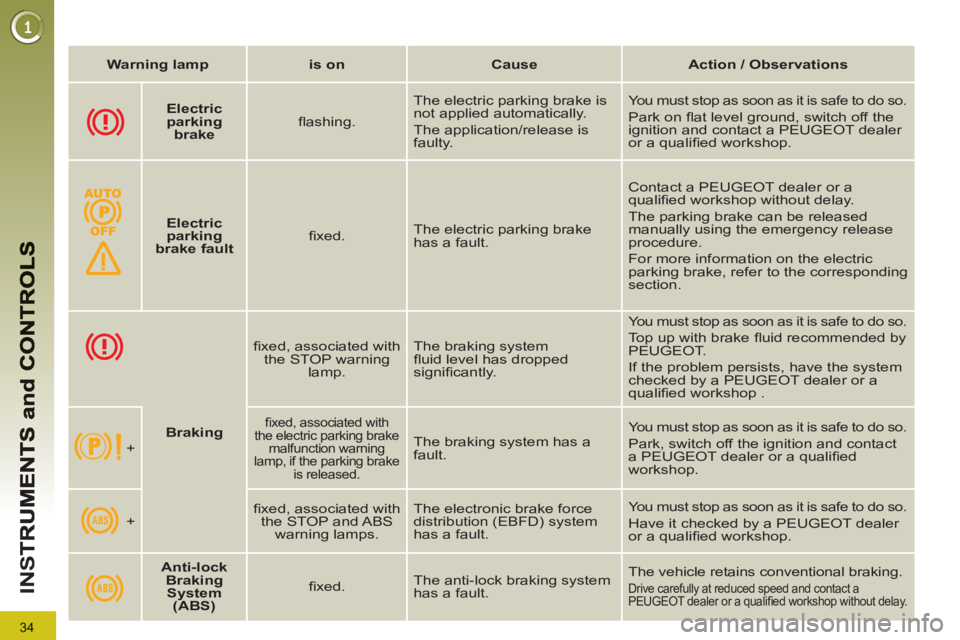
34
IN
S
Warning lamp
is on
Cause
Action / Observations
Electric
parking
brake
fl ashing. The electric parking brake is
not applied automatically.
The application/release is
faulty.
You must stop as soon as it is safe to do so.
Park on fl at level ground, switch off the
ignition and contact a PEUGEOT dealer
or a qualifi ed workshop.
Electric
parking
brake fault
fi xed. The electric parking brake
has a fault. Contact a PEUGEOT dealer or a
qualifi ed workshop without delay.
The parking brake can be released
manually using the emergency release
procedure.
For more information on the electric
parking brake, refer to the corresponding
section.
Braking
fi xed, associated with
the STOP warning
lamp. The braking system
fl uid level has dropped
signifi cantly.
You must stop as soon as it is safe to do so.
Top up with brake fl uid recommended by
PEUGEOT.
If the problem persists, have the system
checked by a PEUGEOT dealer or a
qualifi ed workshop .
+
fi xed, associated with
the electric parking brake
malfunction warning
lamp, if the parking brake
is released.
The braking system has a
fault. You must stop as soon as it is safe to do so.
Park, switch off the ignition and contact
a PEUGEOT dealer or a qualifi ed
workshop.
+
fi xed, associated with
the STOP and ABS
warning lamps. The electronic brake force
distribution (EBFD) system
has a fault.
You must stop as soon as it is safe to do so.
Have it checked by a PEUGEOT dealer
or a qualifi ed workshop.
Anti-lock
Braking
System
(ABS)
fi xed. The anti-lock braking system
has a fault. The vehicle retains conventional braking.
Drive carefully at reduced speed and contact a
PEUGEOT dealer or a qualifi ed workshop without delay.
Page 55 of 352

53
M
U
Monochrome screen C
16/9 colour screen
TRIP COMPUTER
System which provides current infor-
mation concerning the trip (range, con-
sumption…).
Depending on your vehicle's
equipment, the trip computer
information appears on the
multifunction screen or on the instru-
ment panel screen.
Instrument panel screen
Information displays
With the screen C or the colour screen
�)
Press the button, located at the end
of the wiper stalk
, to display the
various trip computer tabs in suc-
cession.
With the instrument panel screen
�)
Press the up and down arrows on
the navigator to display the various
trip computer tabs in succession.
Page 121 of 352
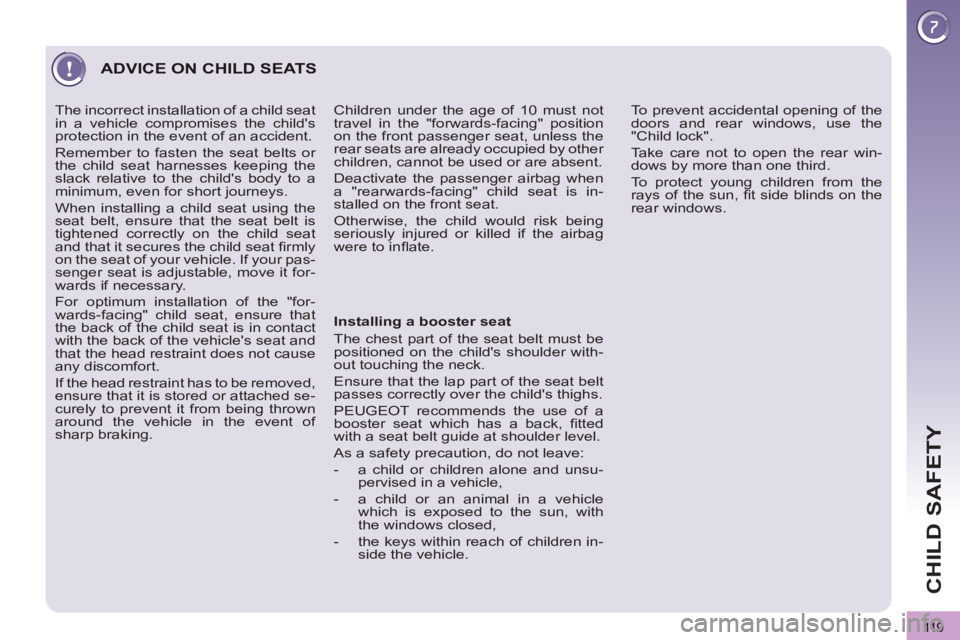
119
CHILD SAFETY
ADVICE ON CHILD SEATS
Installing a booster seat
The chest part of the seat belt must be
positioned on the child's shoulder with-
out touching the neck.
Ensure that the lap part of the seat belt
passes correctly over the child's thighs.
PEUGEOT recommends the use of a
booster seat which has a back, fi tted
with a seat belt guide at shoulder level.
As a safety precaution, do not leave:
- a child or children alone and unsu-
pervised in a vehicle,
- a child or an animal in a vehicle
which is exposed to the sun, with
the windows closed,
- the keys within reach of children in-
side the vehicle. To prevent accidental opening of the
doors and rear windows, use the
"Child lock".
Take care not to open the rear win-
dows by more than one third.
To protect young children from the
rays of the sun, fi t side blinds on the
rear windows.
Children under the age of 10 must not
travel in the "forwards-facing" position
on the front passenger seat, unless the
rear seats are already occupied by other
children, cannot be used or are absent.
Deactivate the passenger airbag when
a "rearwards-facing" child seat is in-
stalled on the front seat.
Otherwise, the child would risk being
seriously injured or killed if the airbag
were to infl ate. The incorrect installation of a child seat
in a vehicle compromises the child's
protection in the event of an accident.
Remember to fasten the seat belts or
the child seat harnesses keeping the
slack relative to the child's body to a
minimum, even for short journeys.
When installing a child seat using the
seat belt, ensure that the seat belt is
tightened correctly on the child seat
and that it secures the child seat fi rmly
on the seat of your vehicle. If your pas-
senger seat is adjustable, move it for-
wards if necessary.
For optimum installation of the "for-
wards-facing" child seat, ensure that
the back of the child seat is in contact
with the back of the vehicle's seat and
that the head restraint does not cause
any discomfort.
If the head restraint has to be removed,
ensure that it is stored or attached se-
curely to prevent it from being thrown
around the vehicle in the event of
sharp braking.
Page 128 of 352
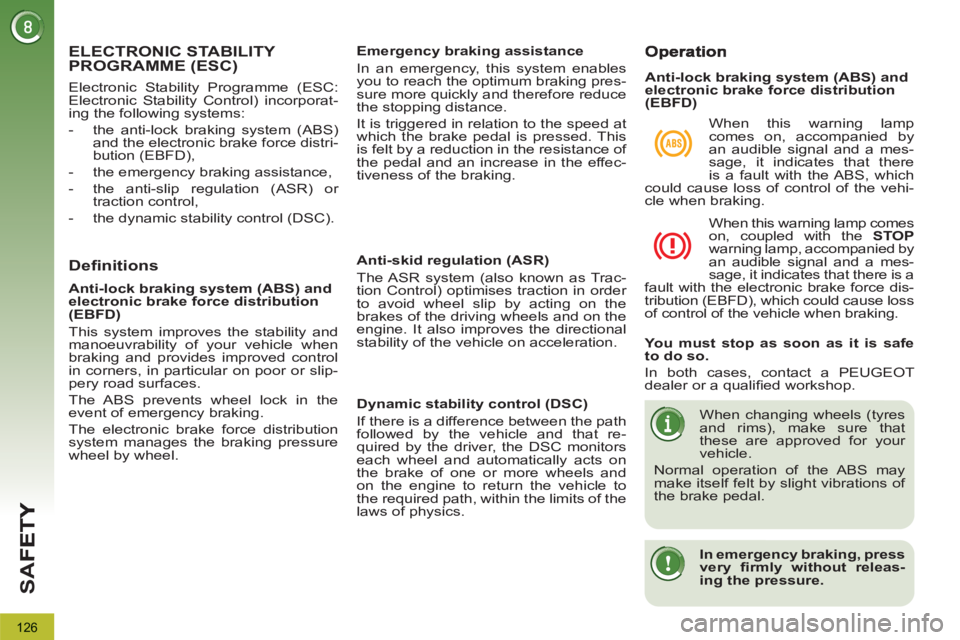
126
SA
F
ELECTRONIC STABILITY PROGRAMME (ESC)
Definitions
Anti-skid regulation (ASR)
The ASR system (also known as Trac-
tion Control) optimises traction in order
to avoid wheel slip by acting on the
brakes of the driving wheels and on the
engine. It also improves the directional
stability of the vehicle on acceleration.
Dynamic stability control (DSC)
If there is a difference between the path
followed by the vehicle and that re-
quired by the driver, the DSC monitors
each wheel and automatically acts on
the brake of one or more wheels and
on the engine to return the vehicle to
the required path, within the limits of the
laws of physics.
Emergency braking assistance
In an emergency, this system enables
you to reach the optimum braking pres-
sure more quickly and therefore reduce
the stopping distance.
It is triggered in relation to the speed at
which the brake pedal is pressed. This
is felt by a reduction in the resistance of
the pedal and an increase in the effec-
tiveness of the braking.
Anti-lock braking system (ABS) and
electronic brake force distribution
(EBFD)
This system improves the stability and
manoeuvrability of your vehicle when
braking and provides improved control
in corners, in particular on poor or slip-
pery road surfaces.
The ABS prevents wheel lock in the
event of emergency braking.
The electronic brake force distribution
system manages the braking pressure
wheel by wheel.
When this warning lamp
comes on, accompanied by
an audible signal and a mes-
sage, it indicates that there
is a fault with the ABS, which
could cause loss of control of the vehi-
cle when braking.
When this warning lamp comes
on, coupled with the STOP
warning lamp, accompanied by
an audible signal and a mes-
sage, it indicates that there is a
fault with the electronic brake force dis-
tribution (EBFD), which could cause loss
of control of the vehicle when braking.
You must stop as soon as it is safe
to do so.
In both cases, contact a PEUGEOT
dealer or a qualifi ed workshop.
When changing wheels (tyres
and rims), make sure that
these are approved for your
vehicle.
Normal operation of the ABS may
make itself felt by slight vibrations of
the brake pedal.
In emergency braking, press
very fi rmly without releas-
ing the pressure.
Anti-lock braking system (ABS) and
electronic brake force distribution
(EBFD)
Electronic Stability Programme (ESC:
Electronic Stability Control) incorporat-
ing the following systems:
- the anti-lock braking system (ABS)
and the electronic brake force distri-
bution (EBFD),
- the emergency braking assistance,
- the anti-slip regulation (ASR) or
traction control,
- the dynamic stability control (DSC).
Page 191 of 352

PRACTICAL INFORMATION
Rear lamps
1.
Brake lamps / sidelamps (P21-5W).
2.
Reversing lamps (P21W).
3.
Direction indicators (PY21W-21W).
4.
Sidelamps (P5-5W).
5.
Foglamps (P21W).
Changing brake lamp/sidelamp,
reversing lamp and direction
indicator bulbs
�)
Press the six tabs and remove the
bulb holder.
�)
Remove the plastic cover.
�)
Remove the two lamp unit fi xing
nuts.
�)
Extract the lamp unit carefully from
the outside.
�)
Disconnect the electrical connector.
�)
Turn the bulb a quarter of a turn and
change it.
To r efi t, carry out these operations in re-
verse order.
Page 199 of 352
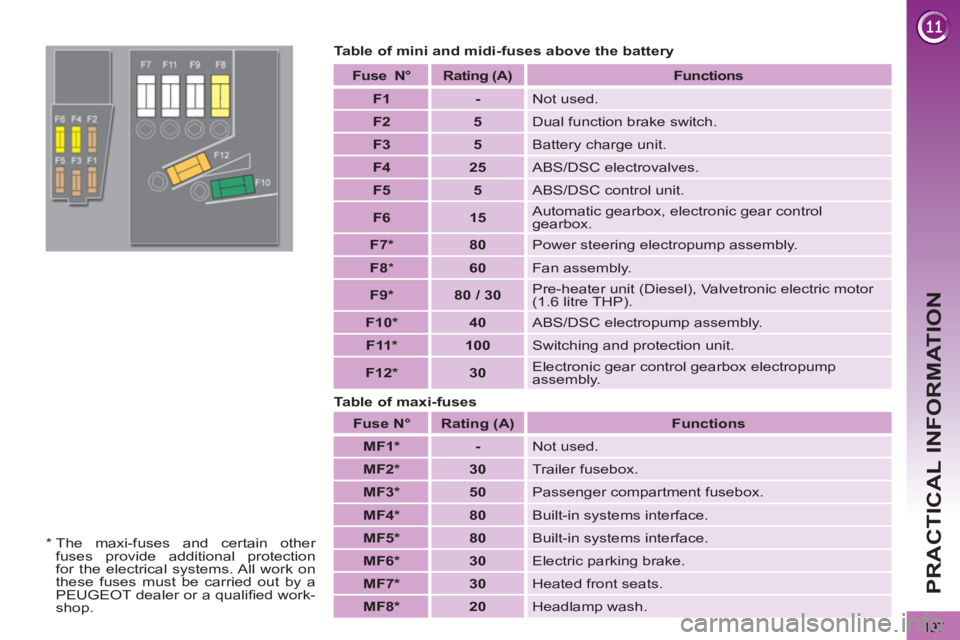
197
PRACTICAL INFORMATION
Table of mini and midi-fuses above the battery
Fuse
N°
Rating
(A)
Functions
F1
-
Not used.
F2
5
Dual function brake switch.
F3
5
Battery charge unit.
F4
25
ABS/DSC electrovalves.
F5
5
ABS/DSC control unit.
F6
15
Automatic gearbox, electronic gear control
gearbox.
F7 *
80
Power steering electropump assembly.
F8
*
60
Fan assembly.
F9 *
80 / 30
Pre-heater unit (Diesel), Valvetronic electric motor
(1.6 litre THP).
F10 *
40
ABS/DSC electropump assembly.
F11 *
100
Switching and protection unit.
F12 *
30
Electronic gear control gearbox electropump
assembly.
Fuse
N°
Rating
(A)
Functions
MF1 *
-
Not used.
MF2 *
30
Trailer fusebox.
MF3 *
50
Passenger compartment fusebox.
MF4 *
80
Built-in systems interface.
MF5 *
80
Built-in systems interface.
MF6 *
30
Electric parking brake.
MF7 *
30
Heated front seats.
MF8 *
20
Headlamp wash.
Table of maxi-fuses
*
The maxi-fuses and certain other
fuses provide additional protection
for the electrical systems. All work on
these fuses must be carried out by a
PEUGEOT dealer or a qualifi ed work-
shop.
Page 260 of 352
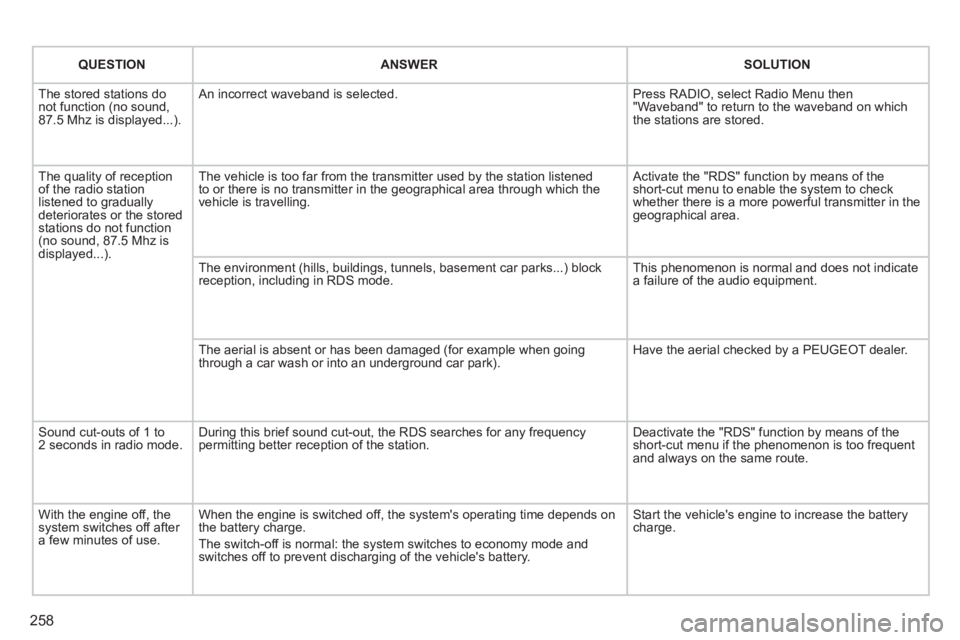
258
QUESTIONANSWERSOLUTION
The stored stations donot function (no sound, 87.5 Mhz is displayed...).
An incorrect waveband is selected.
Press RADIO, select Radio Menu then"Waveband" to return to the waveband on which the stations are stored.
The quality of receptionof the radio station listened to graduallydeteriorates or the stored stations do not function(no sound, 87.5 Mhz is displayed...).
The vehicle is too far from the transmitter used by the station listenedto or there is no transmitter in the geographical area through which the vehicle is travelling.
Activate the "RDS" function by means of theshort-cut menu to enable the system to check whether there is a more powerful transmitter in thegeographical area.
The environment (hills, buildings, tunnels, basement car parks...) block reception, including in RDS mode.
This phenomenon is normal and does not indicate a failure of the audio equipment.
The aerial is absent or has been damaged (for example when goingthrough a car wash or into an underground car park).
Have the aerial checked by a PEUGEOT dealer.
Sound cut-outs of 1 to2 seconds in radio mode.During this brief sound cut-out, the RDS searches for any frequency permitting better reception of the station.
Deactivate the "RDS" function by means of the short-cut menu if the phenomenon is too frequentand always on the same route.
With the engine off, the system switches off after a few minutes of use.
When the engine is switched off, the system's operating time depends on the battery charge.
The switch-off is normal: the system switches to economy mode and switches off to prevent discharging of the vehicle's battery.
Start the vehicle's engine to increase the batterycharge.
Page 315 of 352

313
FREQUENTLY ASKED QUESTIONS
QUESTIONANSWER SOLUTION
Some characters in themedia information are not
displayed correctly while playing. The audio s
ystem does not display some types of characters. Use standard characters to name tracks andfolders.
Pla
ying of streaming fi lesdoes not start. The peripheral device connected does not support automatic play. Start the playback from the device.
Th
e names of tracks and
the track length are not
displa
yed on the screen
when streaming audio. The Bluetooth pro
fi le does not allow the transfer of this information.
The qualit
y of receptionof the radio station listened to graduallydeteriorates or the stored stations do not function(no sound, 87.5 Mhz is
displayed...). The vehicle is too far from the transmitter used b
y the station listened
to or there is no transmitter in the geographical area through which the
vehicle is travelling.
Activate the "RDS" function by means of theshort-cut menu to enable the system to check
whether there is a more powerful transmitter in the
geographical area.
The environment
(hills, buildings, tunnels, basement car parks...) block reception, including in RDS mode. This phenomenon is normal and does not indicate
a fault with the audio system.
The aerial is absent or has been dama
ged (for example when goingthrough a car wash or into an underground car park). Have the aerial checked by a PEUGEOT dealer.
I
cannot fi nd some radiostations in the list of stations received.
The station is not received or its name has changed in the list.
Some radio stations send other information in place of their name(the title of the song for example).
The s
ystem interprets this information as the name of the station. The name of the radio station changes.
Page 338 of 352
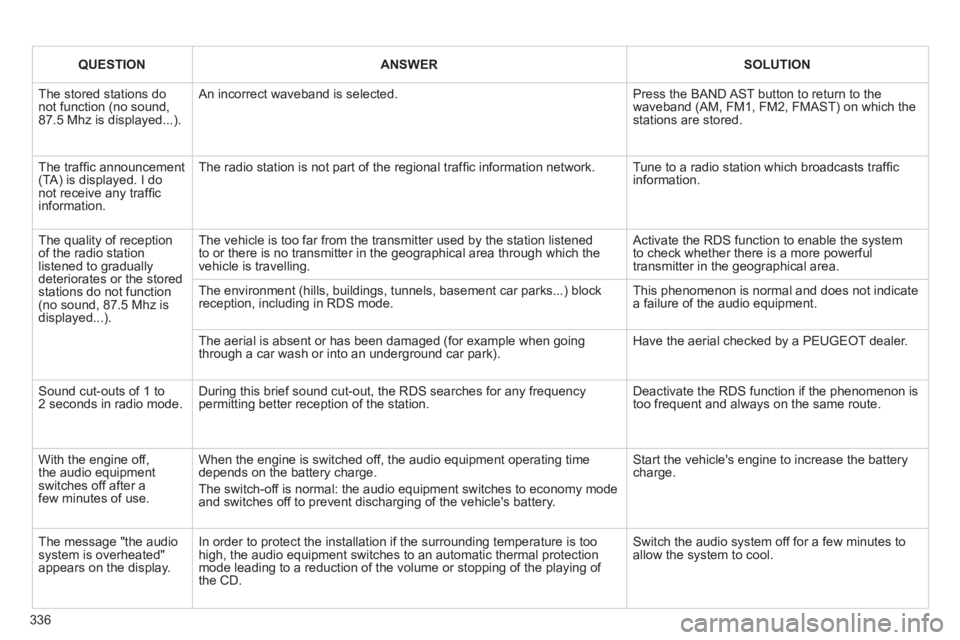
336
QUESTIONANSWERSOLUTION
The stored stations donot function (no sound, 87.5 Mhz is displayed...).
An incorrect waveband is selected.
Press the BAND AST button to return to the waveband (AM, FM1, FM2, FMAST) on which thestations are stored.
The traffi c announcement(TA) is displayed. I donot receive any traffi c information.
The radio station is not part of the regional traffi c information network.
Tune to a radio station which broadcasts traffi c information.
The quality of receptionof the radio station listened to graduallydeteriorates or the stored stations do not function(no sound, 87.5 Mhz is displayed...).
The vehicle is too far from the transmitter used by the station listenedto or there is no transmitter in the geographical area through which the vehicle is travelling.
Activate the RDS function to enable the system to check whether there is a more powerful transmitter in the geographical area.
The environment (hills, buildings, tunnels, basement car parks...) block reception, including in RDS mode. This phenomenon is normal and does not indicate a failure of the audio equipment.
The aerial is absent or has been damaged (for example when goingthrough a car wash or into an underground car park).
Have the aerial checked by a PEUGEOT dealer.
Sound cut-outs of 1 to2 seconds in radio mode.During this brief sound cut-out, the RDS searches for any frequency permitting better reception of the station.
Deactivate the RDS function if the phenomenon is too frequent and always on the same route.
With the engine off, the audio equipment switches off after a few minutes of use.
When the engine is switched off, the audio equipment operating timedepends on the battery charge.
The switch-off is normal: the audio equipment switches to economy mode and switches off to prevent discharging of the vehicle's battery.
Start the vehicle's engine to increase the batterycharge.
The message "the audio system is overheated" appears on the display.
In order to protect the installation if the surrounding temperature is toohigh, the audio equipment switches to an automatic thermal protectionmode leading to a reduction of the volume or stopping of the playing of the CD.
Switch the audio system off for a few minutes toallow the system to cool.
Page 344 of 352

342
VISUAL SEARCH
EXTERIOR
Exterior welcome lighting.............. 89
Door mirror spotlamps .................. 97
Lighting, automatic,
directional ........................ 87-90, 92
Headlamp height adjustment ........ 91
Changing front bulbs ........... 186-188
- front lamps
- foglamps
- direction indicator repeaters
Very cold climate screen............. 205
Wiper ....................................... 93-95
Changing a wiper blade ........ 95, 202
Boot, tailgate............................ 83-84
- opening / closing
- emergency release
Temporary puncture
repair kit ............................ 175-180
Changing a wheel ................ 181-185
- tools
- removing
Remote control key.................. 72-76
- opening / closing
- anti-theft protection
- starting
- battery
Parking sensors ................... 164-165
Towbar ........................................ 204
Towing ................................. 202-203
Changing bulbs.................... 189-190
- rear lamps
- 3rd brake lamp
- number plate lamps
- foglamps
Accessories ................................ 206
Roof bars .................................... 205
Panoramic sunroof ..................... 105
Fuel tank .................................. 85-86
Misfuel prevention ........................ 86
Door mirrors .................................. 69
Doors ....................................... 81-83
- opening / closing
- central locking
- emergency control
Alarm ....................................... 77-78
Electric windows ...................... 79-80
ESC, ABS, EBFD, EBA,
ASR, CDS ......................... 126-127
Grip control .......................... 128-129
Tyre under-infl ation detection ..... 125
Tyre pressures ............................ 213